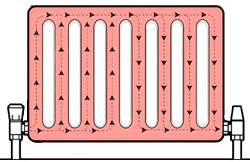What happens during a Power Flush?
The Clearflow power flushing pump is simply connected into the heating system, either across the standard circulator pump couplings, across the tails of one of the radiators or wherever is most practical.
Power flushing is a highly effective cleansing operation which works by pumping water at a much higher velocity than usual through the heating system, to loosen and mobilise harmful corrosion deposits, and to suspend them in the rapidly moving water. The process is made more effective by specialist chemicals, and an instantaneous flow reversal device which creates turbulence in the radiators to optimise pick-up of the debris.
Once loosened, the unwanted debris is purged from the system with clean water. At the end of the flushing process, the system contains fresh clean water, and the reinstatement of the system to normal operations takes only a few minutes.
During the Clearflow process the radiators are individually flushed, without removing or disconnecting them from the system, by directing the full output of the pump through each radiator separately.
Clearflow power flushing is not a high pressure operation, and it is suitable for most domestic wet central heating systems. It is carried out with minimal disturbance or disruption to the normal operation of the system, often without disconnecting the boiler or any radiators.
Before Power Flushing

After Power Flushing
